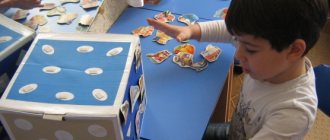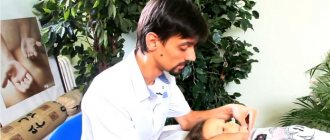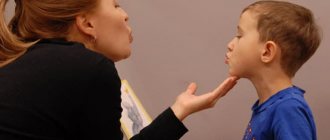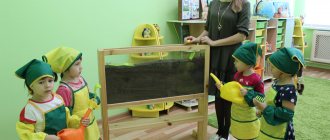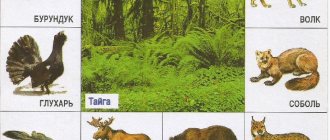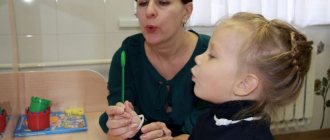Strizhevskaya O.E.
Speech therapy benefit
on the correction of violations of the prosodic aspect of speech of preschool children
Tambov 2014
Strizhevskaya O.E..
The wonderful world of the sounding word. Speech therapy manual for correcting the prosodic side of speech of children of senior preschool age / O.E. Strizhevskaya. – Tambov, 2014. – 30 p.
The album of games and exercises “The Wonderful World of the Sounding Word” is aimed at correcting the prosodic side of the speech of children of senior preschool age. Using the materials of this manual in work will allow the speech therapist to organize effective correctional work to normalize voice, breathing, tempo, rhythm, intonation and expressiveness of speech with the joint participation of teachers of a preschool educational institution and parents of children with speech disorders.
The manual can be used by speech therapists and other teachers of combined and compensatory kindergartens, parents, and students of defectology departments.
O.E. Strizhevskaya , 2014
Guidelines
Preschool age, as is known, is a period of intensive development of the child, and timely acquisition of correct speech is one of the main conditions for normal psychophysical development, the formation of a full-fledged personality and preparation for school.
Speech, in all its diversity, is a necessary component of communication, during which it is, in fact, formed. The process of speech development involves mastering not only the content, but also the figurative, emotional side of the language. A person must master the intonation richness of the language, which is important not only for the formation of a culture of speech, but also for a culture of communication. Therefore, it is very important to begin work on the formation of intonation expressiveness of speech in preschool age, since this work stimulates the development of coherent speech and allows one to avoid such shortcomings of utterance as unclear diction, monotony, and undifferentiated speech that affect the understanding of the content and emotional meaning of the utterance.
In modern speech therapy practice, one of the pressing problems for preschool children is the correction of violations of the prosodic side of speech with erased dysarthria. Unintelligible speech with dysarthria is caused by a disorder of articulation, impaired speech breathing, and voice formation. The prosodic side of speech also suffers, that is, the strength of the voice, tempo, rhythm, intonation and expressiveness.
The relevance of the formation of the main components of the prosodic aspect of speech in preschoolers as a prerequisite for successful schooling is beyond doubt. Insufficient development of the prosodic side of speech in preschool age causes difficulties in communicating with others, and in the future entails certain personality changes, i.e. leads to the emergence of complexes in children, preventing them from learning and fully revealing their abilities and intellectual capabilities.
Education of rhythm and intonation is not only a problem of improving the expressiveness of speech itself - rich rhythmic speech contributes to the overall mental development of the child and facilitates learning. A child with expressive speech feels more relaxed and confident in any environment, thanks to the fact that he can express thoughts and feelings through adequate means and show his creative individuality.
As a rule, children master intonation expressiveness naturally. But as speech therapy examination shows, preschoolers with speech disorders have disturbances in the processes of perception and reproduction of intonation structures. They do not realize the importance of intonation in conveying the meaning of statements and their attitude to what is happening.
Correctional work with such children on the formation of the prosodic side of speech should combine activities aimed at developing speech breathing, rhythm, tempo, strength and modulation of the voice. And also on the formation of perception and reproduction of basic intonation types, the development of the child’s emotional responsiveness and the ability to convey certain feelings and moods using intonation.
Games and exercises to develop voice power
1. “Calm the doll”
Goal: development of voice power.
Description of the game: children sit on chairs in a semicircle. They have dolls in their hands. The teacher says: “The dolls are crying, we need to calm them down. Look how I put the doll to sleep (rocks the doll, humming softly on the sound a
motive of a familiar lullaby).
Now you shake it.” Children take turns and then rock the dolls together, pronouncing the sound a .
2. "Blizzard"
Goal: development of voice strength and speech breathing. Activation of the lip muscles.
Equipment: story picture “Blizzard”.
Description of the game: the teacher shows a picture of a blizzard. Children sitting in a row depict a blizzard howling on a stormy evening. At the signal from the teacher, “The blizzard is beginning,” they quietly say: oooh...;
at the signal “The blizzard is ending” they speak more quietly; at the signal “The blizzard is over” they fall silent. It is advisable that children change the strength of their voice at least 2-3 times in one exhalation. In this case, it is more convenient to replace the teacher’s verbal instructions with conducting: a smooth movement of the hand up - the children speak louder, a smooth movement of the hand down - the children speak more quietly.
- "Beep"
Goal: same as in the previous game.
Description of the game: children stand in a row facing the teacher and raise their arms up from the sides, touching with their palms, but do not clap. Then slowly lower it down through the sides. Simultaneously with lowering their hands, children pronounce the sound u
loudly at first, and then gradually quieter. They lower their hands and fall silent.
First, the teacher himself shows the actions, then calls two children who perform the actions together with him and pronounce the sound, the rest of the children only make movements with their hands. Then the whole group plays.
4. “Who wins?”
Goal: development of voice strength and speech breathing. Activation of the muscles of the lips and lower jaw.
Description of the game: the teacher calls two children and puts them facing each other. At the teacher’s signal, the children simultaneously begin to draw out, first quietly, then loudly, the vowel sounds a, o, u, i, e.
- "The wind blows"
Goal: development of voice strength and speech breathing.
Description of the game: children and teacher stand in a circle. The teacher says: “We went for a walk in the forest in the summer.” Everyone joins hands and leads a round dance, and the teacher continues: “We are walking through the field, the sun is shining, a light breeze is blowing and the grass and flowers are swaying.” The teacher and children stop. “The wind blows quietly, like this: v-v-v
(pronounces the sound c quietly and for a long time).
The children repeat after him. Then the movement of the round dance continues under the leisurely speech of the teacher: “We came to the forest. We picked a lot of flowers and berries. We got ready to go back. Suddenly a strong wind blew: v-v-v...”
- the teacher pronounces this sound loudly and for a long time. Children stop and repeat the sound after the teacher. Methodological instruction: the teacher makes sure that the children, repeating after him, maintain the same strength of voice.
Games and exercises
on the development of perception of voice timbre
- “Who is afraid of vaccinations?”
Goal: to learn to determine the emotional coloring of a phrase by the timbre of the voice.
Material: subject pictures depicting people and animals.
Description: object pictures are laid out in front of the children. The teacher pronounces the phrase: “I’m not afraid of vaccinations, if necessary, I’ll inject myself” with different emotional connotations (joy, sadness, fear, etc.) on behalf of each character depicted. Children determine from the teacher’s voice what feelings the character is experiencing and answer the question “Who is afraid of vaccinations?”
- "Guess"
Goal: to strengthen the skills of perceiving the timbre color of the voice.
Description: the teacher pronounces phrases in a happy, sad, angry, scared or surprised voice. Children determine and name the timbre of the voice with which the phrases are spoken.
- "Letters-Riddles"
Goal: to consolidate the ability to convey the melody of the intonation of a question in expressive speech.
Material: a set of cards on which phrases are encrypted using pictures that replace nouns and arrows that replace verbs. Each card has one or two phrases encrypted, the symbols follow; one after another, like words in a sentence.
Description: the teacher asks to read an encrypted letter and presents the children with one card. The first character (noun-drawing) is shown first, while the remaining characters are covered with thick paper. Since the children do not know the encrypted phrase, the teacher asks them to name each word with a questioning intonation, i.e. with increasing melody. Then the next symbol (arrow) is shown, the children select a verb that is suitable in meaning (it is advisable to listen to several guesses) and pronounce two words together, but the melody increases already on the second word. This happens until all the symbols are opened, after which the entire phrase is pronounced in its entirety in accordance with the punctuation mark.
- "Bear Cubs"
Goal: to consolidate the ability to arbitrarily change the timbre of the voice.
Material: three bear masks.
Description: two children play the roles of bear cubs, one - a she-bear. The cubs ask their mother in a high voice: “Mammyodunammm, mammolokabynammm.” The she-bear replies in a low voice: “That’s all, that’s all!” The cubs run away and sing their request in a low voice, the bear threatens them with her paw and answers in a high voice: “Wow, wow!”
- "Call me kindly"
Goal: to consolidate the ability to convey melody and completeness intonation in expressive speech.
Description: children are asked to repeat after the teacher a phrase with an intonation of completeness, replacing all nouns with “affectionate” ones using diminutive suffixes, for example, the sample phrase “The fox has a fluffy tail” should sound like this: “The fox has a fluffy (or “fluffy” is allowed ") tail".
Games and exercises
on the development of perception of speech tempo
- "Drummer"
Goal: to encourage children to use their movements to reproduce the tempo set by the teacher in speech.
Material: “drums” - tactile “rugs” measuring 18x25 cm (the size is not of fundamental importance, the main thing is that both hands of the child fit on the rug), made of different materials: a piece of carpet, a plastic board, velvet paper.
Description: the teacher pronounces the text of the poem, randomly changing the tempo (from fast to slow and vice versa), the children tap out the given tempo on their “drums” with their palms. After one or two repetitions, the teacher offers each child a rug made of a different material.
Left, right! Left, right! A detachment is going to the parade. A detachment is going to the parade. The drummer is very happy: He drums and drums for an hour and a half straight. Left, right! Left, right! The drum is already full of holes.
- "Autumn Leaves"
Purpose: to form an idea of tempo (“fast”, “moderate”, “slow”). Material: red (“slow”), yellow (“moderate”) and green (“fast”) circles.
Description: children sitting at a table or on the carpet are asked to place symbol circles in front of them in the order in which the teacher changes the tempo of speech while reading the poem.
Leaf fall, leaf fall, Yellow leaves are flying. Yellow maple, yellow beech, Yellow circle of the sun in the sky. Yellow yard, yellow house. The whole earth is yellow all around. Yellowness, yellowness, So autumn is not spring.
The game is repeated several times. When reading again, the tempo of pronouncing each line changes.
Games and exercises
on the development of perception of speech rhythm
- "Bullcocks"
Goal: to consolidate the skill of identifying an unexpected accent by ear.
Material: rooster hats - for every child.
Description: the teacher slowly pronounces various syllables, randomly placing emphasis on one of them. Children stand in pairs facing each other, holding their hands behind their backs, and swing their legs back, raising their shins high. On the accented syllable, they raise their hands up, as if showing a beautiful rooster comb, then continue moving their legs until the next accent.
- "Magic Mirror"
Goal: development of rhythmic, expressive speech and coordination of movements.
Description: children stand in a circle or sit on chairs. The driver approaches one of the guys and says:
Come on, look at the mirror! Repeat everything to us correctly! I will stand in front of you, repeat everything after me!
The driver pronounces any phrase, accompanying it with any movements. The one to whom he addressed must accurately repeat both the phrase and the movement. If a child makes a mistake, he is eliminated from the game. The new driver is the one who completes everything without mistakes. The teacher monitors the correctness of breathing pauses and phrasal speech of children.
Games and exercises to develop perception
melodic-intonation side of speech
- "Conductors"
Goal: to develop skills in perceiving a lower pitch (melody), to develop speech hearing.
Material: “conductor’s” batons (according to the number of children).
Description: the teacher pronounces a series of sounds, syllables and phrases with a lower pitch. When the teacher plays them again, the children conduct with a baton, depicting the downward movement of the melody.
- "Balloon"
Goal: to learn to differentiate by ear different types of melody: with lowering, raising and breaking the fundamental tone of the voice.
Material: a cardboard rectangle measuring 20x55 cm with a vertical slot along which a “balloon” made of thick cardboard with a holder attached to it moves.
Description: the child moves the “balloon” along the slot, focusing on the rise and fall of the fundamental tone of voice (melody) of the teacher, who pronounces individual phrases.
- "Request"
Goal: to consolidate the ability to convey the melody of intonation of assessment in expressive speech.
Description: following the example of a teacher, children give each other instructions and, based on the results of completion, pronounce words of approval with an evaluative intonation: “Well done!”, “What a great fellow you are!”, “You did great!” etc..
on the development of intonation coloring of speech
- "Mimic Fan"
Purpose: exercises on the external manifestation of emotions and intonation of phrases. Description: children repeat a proposed or independently composed phrase with the intonation chosen on the fan or set by the teacher.
- "Overheard Conversation"
Description: the pictures show leaves (snowflakes, etc.) with schematic drawings of various emotional states. Children look at them, recognize them and tell them what they think or feel.
For example, a sad car in the garage: “After a long journey, I’m standing dusty, dirty, and the owner left and forgot to wash me.”
Fun car: “Now my master will come, and we will go on an amazing, joyful journey!”
- "Conversation in a Basket of Vegetables"
Description: children put on a “bracelet” with a picture of a vegetable or fruit with some kind of facial expression and, with the help of facial expressions and intonation, convey a conversation that corresponds to a given emotional state.
- "Broken TV"
Description: children make up a sentence or story based on an object or plot picture, conveying a given emotional state.
- "Letter"
Description: children compose a story (letter) based on two or three emotional states depicted on pictogram cards.
- "Masks"
Description: asking questions like: “Am I funny? Am I sad?”, the child recognizes his mask and then repeats the phrase (answers a question, recites a poem) with the appropriate intonation.
Health-saving technologies in speech therapy
For corrective work on impaired prosody, speech therapy uses health-saving technologies. They are widely used in preschool educational institutions and other institutions involved in improving speech disorders, as they comply with the Federal State Educational Standard. The very definition of the “preserve health” method means the use of various types of vigorous activity:
- breathing exercises;
- eye exercises;
- articulatory gymnastics;
- the main component is logorhythmics.
Lithotherapy in speech therapy
According to the dictionary, lithotherapy in speech therapy is an unconventional way of treating speech disorders using stones, sand, and clay. The main examples of treatment using lithotherapy for speech underdevelopment:
- finger massage while squeezing and rolling stones in your hands;
- laying out patterns from stones and sand;
- burying stones in the sand;
- speech therapy exercises using stones.
Techniques for correcting speech expressiveness deficiencies
The famous professor L. S. Volkova and associate professor R. I. Lalaeva, who have many diplomas in speech therapy and lecture on this topic, have developed a method for correcting speech expressiveness disorders. This structural work is a good assistant for specialists involved in the elimination of speech underdevelopment. According to Volkova, the main areas of activity of a speech therapist teacher include the following:
- distinguishing intonation of separately expressive and impressive speech;
- speech breathing exercises;
- exercises for rhythm and tempo of voice;
- distinguishing tone in statements, questions and exclamations;
- work on the strength and range of your voice;
- exercises with logical stress.
The prosodic side of speech in speech therapy means its expressiveness. In preschool age, most often, disorders occur in prosody. There is no way to correct a conversational underdevelopment overnight. This is a rather lengthy and complex process. But with proper and comprehensive treatment, it can be corrected.
expressive side of speech
Goal: alternately highlighting words with intonation at the beginning, middle and end of a sentence.
Description: reading tongue twisters should begin at a slow pace, while clearly pronouncing each word. Gradually speed up the pace, but make sure that the child maintains clarity, clarity of pronunciation and maintains the necessary intonation.
Malanya the chatterbox chattered and blurted out milk,
I didn’t blurt it out.
Sasha sewed a hat for Sashka, Sashka knocked off a bump with his hat.
In the hut the yellow dervish from Algeria rustles with silks and, juggling with knives, eats figs.
Cuckoo bought a hood. Put on the cuckoo's hood. How funny he is in the hood!
The bull's white lip was blunt.
Two puppies, cheek to cheek, nipping at the brush in the corner.
On Mount Ararat
Varvara was picking grapes.
The mouse crawled under the lid, To gnaw the crumb under the lid, The mouse must be dead - The mouse forgot about the cat!
It's a hassle to catch a cunning magpie, but forty forty is forty hassle.
Mom did not spare soap.
Mom washed Mila with soap.
Mila didn't like soap
Mila dropped the soap.
The parrot said to the parrot: I will parrot you, parrot. The parrot answers him: Parrot, parrot, parrot!
There is grass in the yard, there is firewood on the grass: one firewood, two firewood -
Don't cut wood on the grass in your yard.
The ships tacked, but did not tack.
I was at Frol’s, I lied to Frol about Lavra, I’ll go to Lavra, I lie to Lavra about Frol.
Prokhor and Pakhom were riding on horseback.
The fellow ate thirty-three pie pies, all with cottage cheese.
Karl stole corals from Clara, Clara stole a clarinet from Karl.
The bear cub was frightened, Hedgehog with the hedgehog and the hedgehog, Swift with the swift and the little haircut.
Tell us about your purchases, what kind of purchases? About shopping, about shopping, About my shopping.
The otter dived into the otter's bucket. The otter drowned in a bucket of water.
The Greek was driving across the river, He saw the Greek - there was a cancer in the river. He put the Greek's hand into the river, Cancer grabbed the Greek's hand - tsap!
Senka and Sanka are carrying Sonya on a sled.
Coconut cookers boil coconut juice in coconut cookers.
Old talkative women live in a hut at the edge of the forest. Every old lady has a basket, There is a cat in every basket, Cats in baskets
sew boots for old women.
On the beaver because of the spruce
gazelle eyes stare.
Mila washed the bear with soap, Mila dropped the soap. Mila dropped the soap, but didn’t wash Mishka with soap.
From the clatter of hooves
dust flies across the field.
Four turtles
four turtles.
Small tongue twisters must be pronounced in one exhalation. Maintain the smoothness and consistency of their pronunciation.
Development of the prosodic aspect of speech in preschool children with rhinolalia
The article discusses issues of speech impairment due to rhinolalia. A methodology for working on the voice with children with rhinoplasty is proposed, in the form of a set of exercises that teachers can use in their work.
Rhinolalia (Greek rhinos - nose, lalia - speech) is a violation of the timbre of the voice and sound pronunciation, caused by anatomical and physiological defects of the speech apparatus.
Rhinolalia is characterized by the presence of an altered nasal (from Latin nasus - nose) timbre of the voice, resulting from excessive or insufficient resonance in the nasal cavity during speech.
Such a violation of resonance occurs from the incorrect direction of the vocal-exhalatory stream due to either organic defects of the nasopharynx, nasal cavity, soft and hard palate, or disorders of the soft palate.
Speech disorders with congenital cleft of the hard and soft palate are manifested by a more complex syndrome, including general speech underdevelopment, rhinolalia and rhinophonia. In addition, such children have impaired ventilation of the lungs, general physical weakness and fear of speech. Quite often, concomitant hearing loss is detected. A natural consequence of a defect in the hard and soft palate is difficulty swallowing when eating.
With rhinolalia, speech develops late (the first words appear by two years and much later) and has qualitative features.
Impressive speech develops relatively normally, while expressive speech undergoes some qualitative changes. [1]
First of all, it should be noted that the children’s speech is extremely slurred. The words and phrases that appear in them are difficult to understand for those around them, since the sounds that are formed are unique in articulation and sound. Due to the defective position of the tongue in the oral cavity, consonant sounds are formed mainly due to changes in the position of the tip of the tongue (with little participation of the tongue root in articulation) with excessive activation of the facial muscles.
Prosody in children with congenital cleft lip and palate is sharply reduced. The voice suffers, vocal modulations in height and strength, speech exhalation is weakened. The timbre of speech is disrupted and a nasal tone appears, and the rate of speech is often accelerated. Voice disorder in rhinolalia is multifaceted. The leading one is a change in the timbre of the voice - nasalization (unpleasant nasal resonance, giving a blurred, dull sound to all speech. Lack of differentiation between the nasal and oral cavities. It significantly changes the acoustic characteristics of phonemes, the voice becomes monotonous, unflying, weak, deaf and compressed.
In general, children's voices are characterized by weakness, monotony and hoarseness. (Solomatina). When reciting poems, the child’s speech is monotonous, gradually becomes less intelligible, and the voice fades away. The voice during speech is quiet, modulation in pitch and strength of the voice is not possible (the child cannot change the pitch of the voice by imitation, imitating the voices of animals: cows, dogs). Some children have a shortened speech exhalation, and they speak while inhaling. In this case, speech becomes choked. Quite often, children with good self-control are identified who, when examining their speech, do not show deviations in sound pronunciation, since they pronounce words chanting, that is, syllable by syllable, and only prosody violations come first. [2]
Correction and development of the prosodic side of speech in complex speech therapy is important; the main objectives of these activities are the development of the natural voice data of children with rhinoplasty, normalization of the timbre and strength of the voice, as well as the development of correct voice skills.
Measures that help improve the voice of children with rhinoplasty before plastic surgery of the palate include physiological and phonation (speech) breathing, prevention of degeneration of the muscles of the pharynx and palate, and correction of sound pronunciation. After the operation, work on the voice consists of breathing exercises that lengthen exhalation and activate the internal intercostal muscles and mobility of the diaphragm, strengthening the velopharyngeal closure, and developing the skill of correct voice production. [3]
The proposed method of working on the voice with children with rhinoplasty, in the form of a set of exercises, was developed on the basis of methods by such authors as I.I. Ermakova, E.E. Shevtsova, L.V. Zabrodina, E.A. Soboleva G.N. Solomatin and V.M. Vodolatsky, L.I. Belyakova, N.N. Goncharova, T.G. Shishkova.
Work in the postoperative period includes 2 stages, which must take place in strict sequence. The duration of each stage is determined by the results of the work. Training is carried out using various methodological techniques: games, imitative-performing, creative exercises, as well as observation, examination of paintings and drawings.
At stage 1, work is carried out to develop correct speech breathing; this stage is basic. Children learn how to inhale and exhale correctly. First, work is done on differentiated exhalation (inhale through the nose, exhale through the mouth; inhale through the mouth, exhale through the nose). Then children with rhinolalia practice the ability to inhale through the nose and exhale through the mouth. For this purpose, exercises “Candle”, “Wind”, “Porridge”, “Blind”, “Fish” are used, aimed at developing prolonged exhalation through the mouth.
After breathing exercises, a set of exercises is carried out for several weeks according to the author’s method of developing speech breathing, proposed by L.I. Belyakova, N.N. Goncharova, T.G. Shishkova. Training using this method allows children with rhinolalia to normalize their voice, intonation expressiveness of speech in general, and also contributes to the correct programming of speech utterances.
Work on breathing includes 3 sets of exercises aimed at developing nasal inhalation, phonation exhalation and correct speech breathing.
At stage 2, vocal exercises are performed with children, which give the best effect in solving the main task - the development of mobility of the velum. The use of vocal exercises in training is based on the close connection between the soft palate and the larynx.
Vocal exercises stretch the velum, disinhibit and simultaneously activate all the muscles of the larynx and pharynx, force the child to open his mouth wider and increase the strength of sound.
The methodology for conducting phonopedic exercises and their sequence for rhinolalia have a number of features.
At stage 2, these exercises are reduced to singing vowels: at the beginning of the sounds A, E, after 2 - 3 lessons O, I, U are added. To expand the range, increase the strength of the voice, and develop intonation, the exercises are modified: they change the key, sing quietly and loudly. When performing vocal exercises correctly, the nasal tint in singing initially decreases significantly and gradually disappears completely.
After activating the velopharyngeal closure, establishing diaphragmatic-costal breathing and mastering the ability to pronounce vowels without a nasal tint, the voices move on to exercises to develop the skill of correct voice production, expand the range, increase the strength of the voice and finally remove nasality.
The number of vowels in combination gradually increases to three sounds. When practicing pronouncing vowel sounds, there is no need to follow the given order of sounds. The speech therapist himself selects the combinations necessary for the sound composition.
Pronunciation of vowels is carried out in a certain order with a focus on the degree of elevation and tension of the velum palatine. It is important to draw the child’s attention to the wide opening of the mouth, the movement of the tip of the tongue forward to the lower incisors, to the sensation of opening the pharynx and correct, relaxed phonation. For children with a healthy vocal apparatus, several sessions of teaching correct phonation may be sufficient. Once children have a kinesthetic sense and can differentiate the correct phonation by ear, they will be able to build on it in all subsequent exercises to expand the range and increase the strength of the voice.
Then they move on to “mooing” - a drawn-out pronunciation of the sound M with fixation of attention on the nasal resonance of the consonant (children sometimes tend to replace nasal M, N with oral B, D after surgery).
The choice of phoneme M as the initial one for voice production in phonopedic practice is determined by its physiological basis, convenient for correct phonation. It is characterized by slight tension, pronounced resonance of the nasal and accessory cavities, which ultimately activates the functioning of the vocal apparatus. When pronouncing M with closed lips, lowered root of the tongue and a small gap between the teeth, the sound can be easily produced “into the mask”. Initially, the phoneme is pronounced briefly, but gradually the sound is lengthened.
After the child learns to pronounce the phoneme M without tension in the tone of voice that is most comfortable and natural for him, they begin to pronounce open syllables with the sound M together, relying on this sound: MA, MO, MU, ME, WE. Exercise 6-8 times a day immediately after short pronouncing M three times. [3]
Literature:
1. Speech therapy: A textbook for students of defectology faculties of pedagogical higher educational institutions / ed. L.S. Volkova, S.N. Shakhovskaya. – 3rd ed., revised. and additional – M.: Vlados, 2003 – 350 p.
2. Solomatina G.N. Elimination of open rhinolalia. Methods of examination and correction / G.N. Solomatina, V.M. Vodolatsky. – M.: Sfera, 2005 – 160 p.
3. Ermakova I.I. Correction of speech and voice in children and adolescents / I.I. Ermakova. – M.: Education, 2000 – 142 p.
Belyankina O.A., teacher-speech therapist
- Rhinolalia
- Development of phonemic processes in children of senior preschool age with general speech underdevelopment of level III
- Development of graphomotor skills in children of senior preschool age with general speech underdevelopment
- Features of mental and physical development of children with open organic congenital rhinolalia
- Development of coherent speech in preschool-aged children with special needs development using picture-graphic plans and diagrams
( 1 liked, average score: 5.00 out of 5)
Loading...
